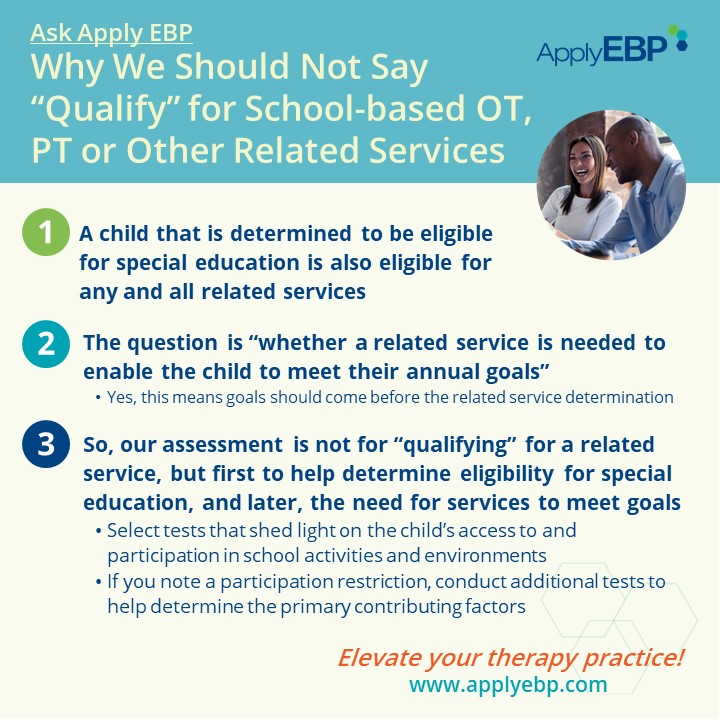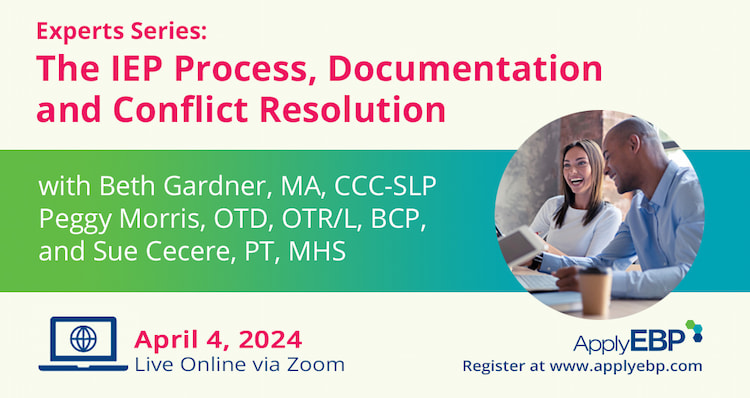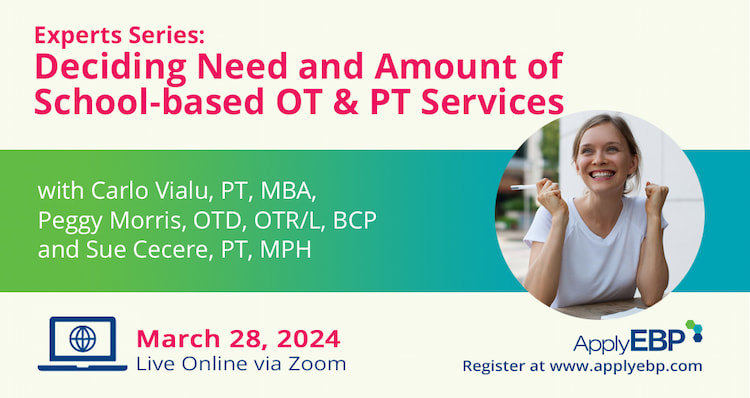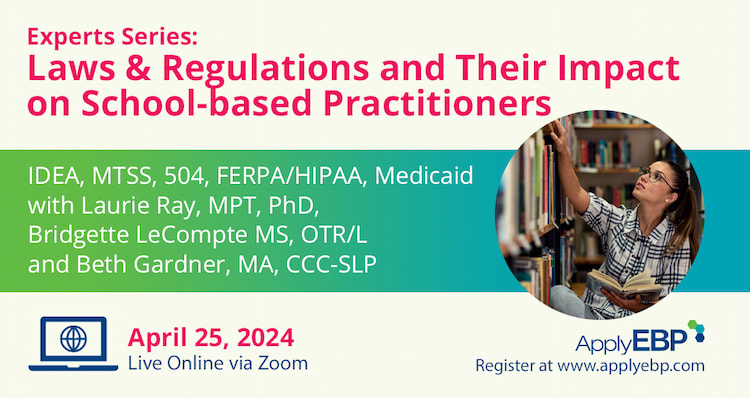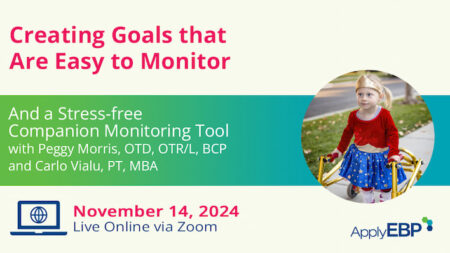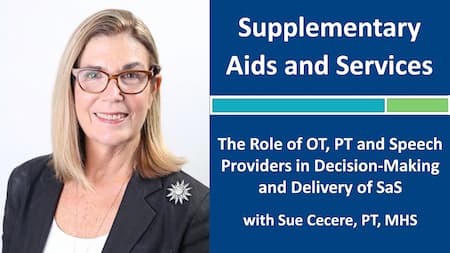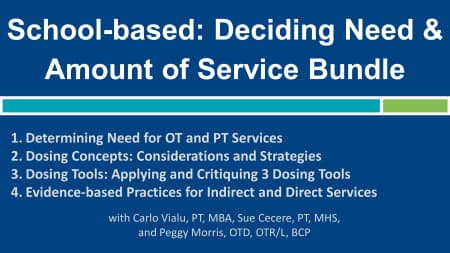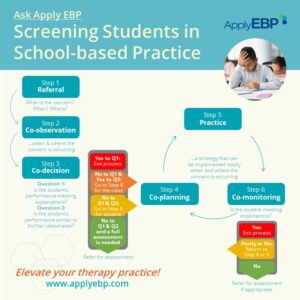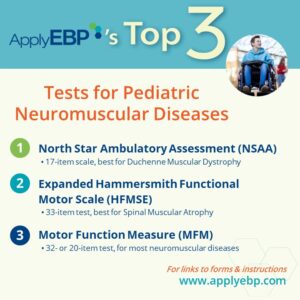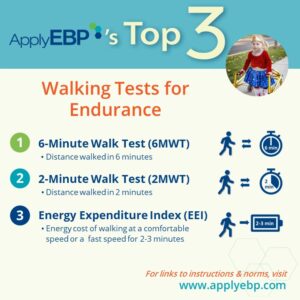Ask Apply EBP
Why We Should Not Say "Qualifying for a School-based Related Service"
Question: You mentioned that we should not use the phrase “qualify for school-based OT, PT, etc.” Why not?
Yes, we do not recommend using the term “qualify” when referring to school-based OT, PT, or other related services. IDEA does not use the term “qualify” to refer to related services. The few times IDEA used the word qualify, it referred to whether the child “qualifies as a child with disabilities”.
In addition, using the word “qualifying” creates confusion. It gives the perception that…
-
-
- Related services are separate from special education, moving our service farther away from the educational model and closer to a medical model
- We alone can “qualify” a child for our services
- We can use a test with a cut-off score to “qualify” a child, when IDEA is clear in Section 1414 (b) (2) (B) that we should “not use any single measure or assessment as the sole criterion for determining whether a child is a child with a disability or determining an appropriate educational program for the child”*
-
Instead, IDEA states that when determining eligibility, the team determines whether the child needs “special education and related services.” This is in quotes since you will often find these two together everywhere in IDEA. This means that once the child is determined to be eligible for special education, they are also eligible for any and all related services! There is no separate “eligibility” or “qualification” for related services.
So, when deciding the need for a related service, use the question “How do we determine the child’s need for a related service (OT, PT, etc.)?”, instead of “How does a child qualify for a related service?” Or say the phrase “determine the need for a related service,” and not “qualify for a related service.”
The Next Question
Now that that is settled…the next reasonable question is “How then do we determine whether a child needs OT, PT, or other related services?”
You will find a clue in Sec 1414 (c) (1) (B) which states that…
-
-
- the team identifies “what additional data, if any, are needed to determine – “(iv) whether any additions or modifications to the special education and related services are needed to enable the child to meet the measurable annual goals set out in the individualized education program of the child and to participate, as appropriate, in the general education curriculum.”
-
So a related service should be provided when it is needed to enable the child to meet their annual goals.
The Carriage Before the Horse; The Chicken or the Egg
I’m sure many of you have experienced this: during the creation of the IEP you are asked, “Does Johnny need PT (or OT, etc.)?” And if you say yes, the next thing you are told is to “Create annual goals for Johnny.”
After what we learned above, these questions sound backward, don’t they? It’s like putting the carriage before the horse.
How can you decide whether a related service is needed to help the child meet their annual goals if the annual goals are not created until after the related service has been determined? Determining related service before the goal would be as aimless as a carriage placed before a horse.
While it may sound like the unanswerable chicken or egg question, we can find more clues in regulations and guidelines on whether goals or related services should come first:
-
-
- IDEA Section 1414 (d) (1) (A) lists what should be included in the IEP. Which one comes first? Goals or related services?
- This is for mental exercise only. To be fair, the IDEA section noted above does not say, include the following “in this order.” But how did the states and/or local education agencies interpret these…
- Look at your school’s IEP form or your state’s sample IEP. Which comes first? Goals or related services?
- There must be some intention in that order. Who would create a form that you are supposed to complete from back to front?
- Next, look at the instructions for completing the IEP form. Here are some examples
- New York State
- “Step 5: Set realistic and measurable annual goals for the student” and
- “Step 7: Determine the special education program and services the student will need”
- This Step 7 also states that “Based on the student’s needs and goals, the Committee must decide what special education program and services, including as appropriate related services…”
- Connecticut
- On the Related Services page (p. 11), it states “Related Services” are designed to enhance the goals and objectives of the IEP.”
- New York State
- Review your state’s practice guideline for school-based OT, PT, or Speech (you can find a listing here from SeekFreaks).
- Most guidelines require that “the IEP team must establish the student’s IEP goals prior to determining the need for related services” (Vialu and Doyle, 2017).
- IDEA Section 1414 (d) (1) (A) lists what should be included in the IEP. Which one comes first? Goals or related services?
-
What We Can Do Now
With this knowledge, here are some suggestions on what we can do now to put the horse in front of the carriage:
-
-
- Stop using the phrase “qualifying the student for OT, PT, or any other related service.” Start using “let’s determine the child’s need for OT, PT, or any other related service.”
- Advocate for the team to set the IEP goals first, before determining what related services may be needed by the child to meet those IEP goals. We know this is not an easy change! Share with them what you learned when you looked for clues in IDEA, state/school IEP forms, and state practice guidelines. Make goals easy to monitor, so anybody can monitor it and be invested in the child’s progress.
- Remember that your assessment is not to qualify the child for a related service. You are collecting data to determine whether the child is eligible for special education and related services.
- So, select tests that shed light on the child’s access to and participation in school activities and environment. Think School Functional Assessment (SFA), Participation and Environment Measure in Children and Youth (PEM-CY), ecological assessment, and the like.
- If you noted a restriction in their access and/or participation in their education, then conduct additional that will help you determine the primary contributing factors to the above-mentioned restrictions. Think Timed Up and Go (TUG) for balance and mobility, Movement ABC for motor coordination, McMaster Handwriting Protocol for writing, and the like. This information can help your team later when you are determining what is likely causing the restrictions, whether this is within the scope of your expertise, and whether your related service is needed to help the child meet their annual goals.
-
Vitamin Cs: Great Side Effects
This transformation in phrasing, thinking, and decision-making has some great side effects. They are the 3 Vitamin Cs to make them easier to remember!
-
-
- It’s more Collaborative.
- It’s Child-centered. Goals become more related to the child’s educational needs.
- It’s more likely to promote Carryover. No more feeling isolated working towards a goal by yourself. A goal created by the team means the team is invested in that goal, not just you. Can better carryover of strategies be far behind?
-
Some Resources
I’m not saying this transformation is easy. No change is! So, here are some resources to help you along the way:
-
-
- Share with your whole IEP team the video on top of this page. You can also find the video on YouTube by clicking here. This video is free to use for non-commercial educational use.
- The hot-off-the-press AOTA, APTA, and ASHA’s Joint Statement on Interprofessional Collaborative Goals in School-based Practice
- This article I co-wrote with Maura Doyle, PT, DPT, lists the 2 procedural requirements and 5 questions you should ask when determining the need for school-based services
- Your state’s school-based practice guideline, if there is one, would be here
-
You can also attend our courses in Apply EBP where we discuss laws and regulations, top-down, and evidence-informed assessment, interventions, and decision-making.
Happy determining needs (not qualifying)! If you have questions about discontinuing services, read this Ask Apply EBP article.
*SOME CAVEATS
The discussion above is for related services under IDEA. If you are interested in more information about services under Section 504, read this SeekFreaks article by Laurie Ray. Also, review your state or school district’s guidelines and regulations as they may differ, for example, in what can be considered specially-designed instruction. Or whether you are in one of the few states that have cut-off scores for determining needs for a related service, particularly for Pre-K.
REFERENCES
Individuals with Disabilities Education Act, 20 U.S.C. § 1400
Vialu, C., & Doyle, M. (2017). Determining need for school-based physical therapy under IDEA: Commonalities across practice guidelines. Pediatric Physical Therapy, 29(4), 350-355.
Find More Answers to Your Questions in Our...
Featured School
Symposium
6th Online School-based OT and PT Symposium - On-demand Version
- Watch and re-watch on your own time
- On-Demand Version
- OTs, OTAs, PTs and PTAs
- $399-449
Featured Live
Workshop
Creating Goals that Are Easy to Monitor
- November 14, 2024, 8:30 am - 3:30 pm Eastern Time
- Online via Zoom
Featured On-Demand
Webinar
Supplementary Aids and Services
Featured Webinar
Bundle
Deciding School-based OT/PT
Have a question?
Submit here…
*Clicking submit will send your question directly to our email inbox. Your name and email will let us know that your submission is real (not spam). We will not include these in our posts, unless you tell us to include your name. Please read our privacy policy here.
All infographics and videos on www.applyebp.com are intellectual properties of Apply EBP, LLC
You may use the infographics and videos for free for any non-commercial, educational purposes. Please cite the source as “Apply EBP, LLC” and a link to the source article. If you plan to use any infographic or video for commercial purposes (i.e., for profit), please email Carlo@applyebp.com to obtain a written permission. Permission can be granted on a case-by-case basis.

